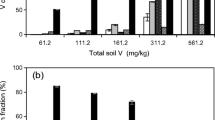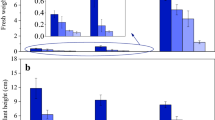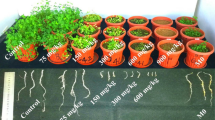Abstract
Greenhouse experiments were conducted to study the permissible value of vanadium (V) based on the growth and physiological responses of green Chinese cabbage (Brassica chinensis L.), and effects of V on microbial biomass carbon (MBC) and enzyme activities in allitic udic ferrisols were also studied. The results showed that biomass of cabbage grown on soil treated with 133 mg V kg−1 significantly decreased by 25.1% compared with the control (P < 0.05). Vanadium concentrations in leaves and roots increased with increasing soil V concentration. Contents of vitamin C (Vc) increased by 10.3%, while that of soluble sugar in leaves significantly decreased by 54.0% when soil V concentration was 133 mg kg−1, respectively. The uptake of essential nutrient elements by cabbage was disturbed when soil V concentration exceeded 253 mg kg−1. Soil MBC was significantly stimulated by 15.5%, while dehydrogenase activity significantly decreased by 62.8% and urease activity slightly changed at treatment of 133 mg V kg−1 as compared with the control, respectively. Therefore, the permissible value of V in allitic udic ferrisols is proposed as 130 mg kg−1.


Similar content being viewed by others
References
Gummow B, Kirsten WFA, Gummow RJ et al (2006) A stochastic exposure assessment model to estimate vanadium intake by beef cattle used as sentinels for the South African vanadium mining industry. Prev Vet Med 76:167–184
Yeoma BY, Lee CS, Hwang TS (2009) A new hybrid ion exchanger: effect of system parameters on the adsorption of vanadium (V). J Hazard Mater 166(1):415–420
Hope BK (1997) An assessment of the global impact of anthropogenic vanadium. Biogeochemistry 37:1–13
Nriagu JO (1998) Vanadium in the environment, Part 1, Chemistry and Biochemistry. Wiley, New York
Reimann C, Caritat P (1998) Chemical elements in the environment. Springer, Berlin
Panichev N, Mandiwana K, Moema D et al (2006) Distribution of vanadium (V) species between soil and plants in the vicinity of vanadium mine. J Hazard Mater A 137:649–653
Wang JF, Liu Z (1999) Effect of vanadium on the growth of soybean seedlings. Plant Soil 216:47–51
Naria RK, Chen CL, Dong YH et al (2001) In vivo antitumor activity of bis (4,7-dimethyl-1,10- phenanthroline) sulfatooxovanadium (IV) {METVAN [VO(SO4)(Me2-Phen)2]}. Clin Cancer 7:2124–2133
Willsky GR, Goldfine AB, Kostlyniak PJ et al (2001) Effect of vanadium(IV) compounds in the treatment of diabetes: in vitro studies with vanadyl sulfate and bis(maltolato)oxovandium (IV). J Inorg Biochem 85:33–42
McCrindle C, Mokantla E, Duncan N (2001) Peracute vanadium toxicity in cattle grazing near a vanadium mine. J Environ Monit 3:580–582
Boulassel B, Sadeg N, Roussel O et al (2011) Fatal poisoning by vanadium. Forensic Sci Int 206(1):79–81
Gummow B, Botha CJ, Noordhuizen JPTM et al (2005) The public health implications of farming cattle in areas with high background concentrations of vanadium. Prev Vet Med 72:281–290
Hindy KT, Abdel SHI, Farag SA (1990) The role of the cement industry in the contamination of air, water, soil and plant with vanadium in Cairo. Environ Pollut 66(3):195–205
Gost 17.4.4.02-84 (1985) Nature protection. Soils. Methods of sampling and preparation of soil samples for chemical analysis. Moscow
Ministry of Housing, Spatial Planning and the Environment (1999) Environment quality standards in the Netherlands, 627
Canadian Council of Ministers of the Environment (1999) Canadian soil quality guidelines for the protection of environmental and human health: vanadium
Jiang KQ, Guo ZH, Xiao XY (2010) Regional distribution of vanadium ore resources and extraction processes of vanadium from stone coal in China. Hydrometallurgy of China 29(1):216–219, 224
Chen J, Wei F, Zheng C et al (1991) Background concentrations of elements in soils of China. Water Air Soil Pollut 57/58:699–712
Teng YG, Yang J, Sun ZJ et al (2011) Environmental vanadium distribution, mobility and bioaccumulation in different land-use district in Panzhihua Region, SW China. Environ Monit Assess 176(1–4):605–620
Xia JQ (1996) Soil environment quality standards. Chinese Environmental Science Press
Page AL, Miller RH, Keeney DR et al (1982) Methods of soil analysis. ASA-SSSA Inc., Madison
USEPA (1996) Test methods for evaluating solid wastes, physical/chemical methods, SW-846. <http://www.epa.gov/epaoswer/hazwaste/test/main.htm>
Song B, Chen TB, Zheng YM et al (2006) A survey of cadmium concentrations in vegetables and soils in Beijing and the potential risks to human health. Acta Scientiae Circumstantiae 26(8):1343–1353
Li YT, Rouland C, Benedetti M et al (2009) Microbial biomass, enzyme and mineralization activity in relation to soil organic C, N and P turnover influenced by acid metal stress. Soil Biol Biochem 41:969–977
Tabatabai MA, Bezdicek DF, Smith S et al (1994) Soil enzymes, methods of soil analysis. Part 2: microbial and biochemical properties. Soil Sci Soc Am 20:775–833, Madison, WI
Ozaki K, Uchida A, Takabe T et al (2009) Enrichment of sugar content in melon fruits by hydrogen peroxide treatment. J Plant Physio 166:569–578
Ministry of Health, People Republic of China (2004) Determination of total ascorbic acid in fruits, vegetables and derived products—fluorimetric method and colorimetric method (GB/T5009.86-2003). Standards Press of China, Beijing
Somasundaram R, Muthuchelian K, Murugesan S (1994) Inhibition of chlorophyll, protein, phytosynthesis, nitrate reductase and nitrate content by vanadium in Oryza sativa L. J Environ Biol 15:41–48
Yang J, Teng YG, Wang JS et al (2011) Vanadium uptake by alfalfa grown in V–Cd-contaminated soil by pot experiment. Biol Trace Elem Res. doi:10.1007/s12011-010-8777-z
Hara T, Sonoda Y, Lwai I (1976) Growth response of cabbage plants to transition elements under water culture conditions. Soil Sci Plant Nutr 22:3117–3315
Chien LT, Hwang DF (2001) Effects of thermal stress and vitamin C on lipid peroxidation and fatty acid composition in the liver of thornfish Terapon jarbua. Comp Biochem Physiol B 128:91–97
Yan ZZ, Lin K, Tam NFY (2010) Lead stress in seedlings of Avicennia marina, a common mangrove species in South China, with and without cotyledons. Aquat Bot 92:112–118
Wilkison RE, Duncan RR (1993) Vanadium influence on calcium (45Ca2+) absorption by sorghum root tips. J Plant Nutr 6:1991–1994
Burzyńki M, Zurek A (2007) Effects of copper and cadmium on photosynthesis in cucumber cotyledons. Photosynthetica 45:239–244
Pérez-de-Mora A, Burgos P, Madejoń E et al (2006) Microbial community structure and function in a soil contaminated by heavy metals: effects of plant growth and different amendments. Soil Biol Biochem 38:327–341
Giller KE, Witter E, McGrath SP (1998) Toxicity of heavy metals to microorganisms and microbial processes in agricultural soils: a review. Soil Biol Biochem 30:1389–1414
Jiang JP, Wu LH, Li N et al (2010) Effects of multiple heavy metal contamination and repeated phytoextraction by Sedum plumbizincicola on soil microbial properties. Eur J Soil Biol 46:18–26
Acknowledgment
The authors are grateful to the foundation of Changsha Science and Technology Project (No. K1003056-31). We also thank Dr. Shu Zhang from Curtin University, Australia for his assistance with the grammar of the manuscript.
Author information
Authors and Affiliations
Corresponding author
Rights and permissions
About this article
Cite this article
Xiao, Xy., Yang, M., Guo, Zh. et al. Permissible Value for Vanadium in Allitic Udic Ferrisols Based on Physiological Responses of Green Chinese Cabbage and Soil Microbes. Biol Trace Elem Res 145, 225–232 (2012). https://doi.org/10.1007/s12011-011-9183-x
Received:
Accepted:
Published:
Issue Date:
DOI: https://doi.org/10.1007/s12011-011-9183-x




